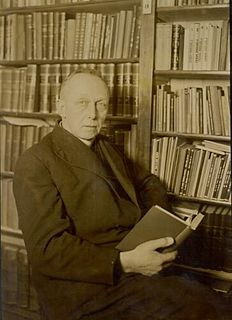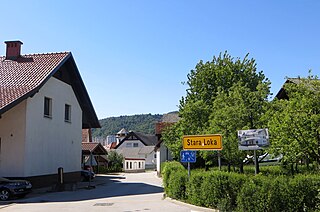
France Prešeren was a 19th-century Romantic Slovene poet whose poems have been translated into English, French, German, Italian, Spanish, Hungarian, Slovak, Polish, Russian, Ukrainian, Belorussian, Bengali, as well as to all the languages of former Yugoslavia, and in 2013 a complete collection of his "Poezije" (Poems) was translated into French.

Vrba is one of ten villages in the Municipality of Žirovnica in the Upper Carniolan region of Slovenia. It was first mentioned in written sources from 1247 and is a typical example of a compact Alpine village. According to the 2002 census, it has a population of 196. The Slovene national poet France Prešeren, who was born in the village, dedicated it the sonnet "O Vrba", the first of his Sonnets of Misfortune.

Fran Saleški Finžgar was perhaps the most popular Slovene folk writer. He is particularly known for his novels and short stories, although he also wrote poems and plays.

Avče is a settlement on the left bank of the Soča River in the Municipality of Kanal ob Soči in the Littoral region of Slovenia. It includes the hamlets of Dolnji Avšček, Gor(e)nji Avšček, and Langa along Avšček Creek southeast of the main settlement, Nadavče to the west, and Spodnji Log and Vrtače to the north along the railroad.

The Franciscan Church of the Annunciation is a Franciscan church located on Prešeren Square in Ljubljana, the capital of Slovenia. It is the parish church of Ljubljana - Annunciation Parish. Its red colour is symbolic of the Franciscan monastic order. Since 2008, the church has been protected as a cultural monument of national significance of Slovenia.

Navje Memorial Park, the redesigned part of the former St. Christopher's Cemetery, is a memorial park in Ljubljana, the capital of Slovenia. It is located in the Bežigrad district, just behind the Ljubljana railway station.

The Prešeren House is a house in the village of Vrba in the Municipality of Žirovnica in Slovenia. It is the house where the Slovene poet France Prešeren was born in 1800. The Slovene theologian and archbishop Anton Vovk was also born in the same house in 1900. The house is a good example of an Upper Carniolan farmhouse. Since 1939, it has housed a small museum collection with furnishings from the poet’s time.
Jernej of Loka (Bartholomew) was a 16th-century painter active in the Škofja Loka area, from which his epithet is also derived. He is known to have painted the frescoes in a number of other churches throughout the Upper Carniola region and some in the area of Tolmin (Slovenia) and in the Natisone Valley (Italy).

"O Vrba" is a sonnet written in 1832 and later corrected by the Slovene Romantic poet France Prešeren, who is considered the national poet of Slovenia. It was published in 1834 in the fourth volume of the almanac Krajnska čbelica. It is the introductory exposition of a cycle of six sonnets, titled the Sonnets of Misfortune. The sonnet is dedicated to the Prešeren's home village of Vrba, expressing a sense of general melancholy over the lost idyll of the rural environment. According to contemporary Slovene literary critics, especially Marija Pirjevec, Boris Paternu and Janko Kos, the meaning of the sonnet is centered on the problem of insecurity and unhappiness of a free subject detached from the theocentric world view. The sonnet form follows the rules abstracted by August Wilhelm Schlegel from the sonnets of Petrarch. In the 20th century, several musical interpretations of the poem were created, the most known of them probably being a version by the Slovene folk rock musician Vlado Kreslin.

Crngrob is a small village in the Municipality of Škofja Loka in the Upper Carniola region of Slovenia.

Suha is a village just outside Škofja Loka in the Upper Carniola region of Slovenia. It is an old settlement, with its earliest mention in documents dating to AD 973.

Stara Loka is a settlement in the Municipality of Škofja Loka in the Upper Carniola region of Slovenia.

Velika Planina is a dispersed high-elevation settlement of mostly herders' dwellings on the karst Big Pasture Plateau in the Kamnik Alps in Upper Carniola region of Slovenia.

Četena Ravan is a small settlement in the Municipality of Gorenja Vas–Poljane in the Upper Carniola region of Slovenia.

Hotavlje is a village in the Poljane Sora Valley in the Municipality of Gorenja Vas–Poljane in the Upper Carniola region of Slovenia.

Topol pri Medvodah is a small settlement in the Municipality of Medvode in the Upper Carniola region of Slovenia. It lies in the hills northwest of the Slovene capital Ljubljana and is a popular destination for short trips with locals.

Briše pri Polhovem Gradcu is a dispersed settlement just south of Polhov Gradec in the Municipality of Dobrova–Polhov Gradec in the Upper Carniola region of Slovenia. It lies in the valley of Little Creek on the road from Polhov Gradec to Lučine and includes the hamlets of Škofijski Hrib, Zavrh, and Štebavnik. It is surrounded by Praproče Hill and Mount Polhov Gradec to the north, Little Peak to the west, Big Hill to the south, Kladnik Hill to the southeast, and Zvonščica Hill to the east.

Ponikve is a clustered settlement in the Municipality of Tolmin in the Littoral region of Slovenia.

Dobračeva is a formerly independent settlement in the town of Žiri in western Slovenia. It is part of the traditional region of Upper Carniola and is now included with the rest of the municipality in the Upper Carniola Statistical Region. It includes the hamlets of Koče and Rakulk.

Catholic church designed by Jože Plečnik located in Bregalnička 14, Zvezdara.




















